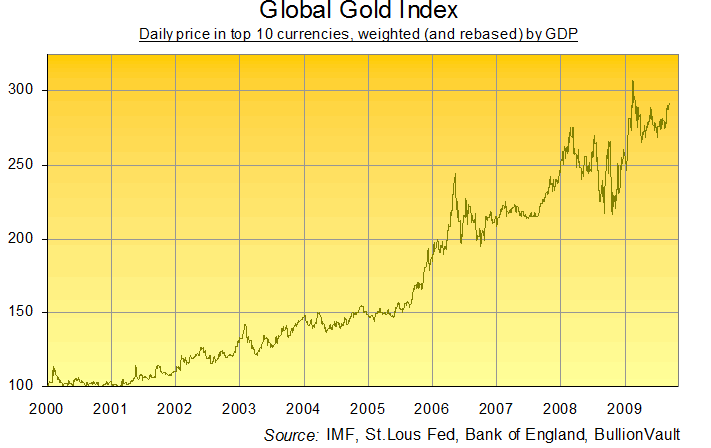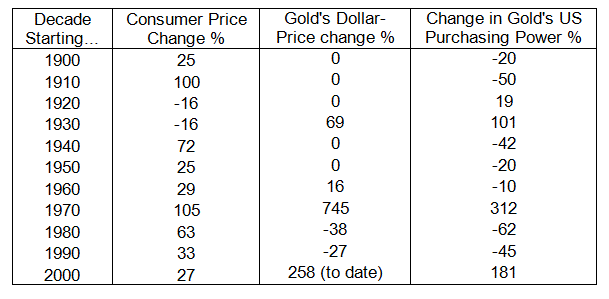The Real Gold Price Analysis
Commodities / Gold & Silver 2009 Sep 18, 2009 - 12:24 PM GMTBy: Adrian_Ash
 Two charts and three measures of gold's "real" price today...
Two charts and three measures of gold's "real" price today...
GOLD'S CURRENT price-tag of $1,000 an ounce suggests big doubts over the US Dollar, its domestic economy, and its status as the world's No.1 reserve currency.
Or so we guess after 10 years of watching it quadruple from two-decade lows. But gold investors (old, new and everywhere) should note that this decade's bull market in bullion is about much more than the greenback.
Here are three ways of judging what you might call the "real price of gold" instead.
#1. The Global Gold Index
Gold has risen against all world currencies since the start of 2001, very nearly tripling on average and hitting record highs against everything bar the Japanese Yen. (Tokyo gold buyers are still waiting for a near-double to the peak of Jan. 1980...)

Introduced in July 2008, BullionVault's Global Gold Index is a stab at mapping this trend. It monitors "real gold" by plotting the daily price in terms of the world's ten most important currencies, averaging their moves by size of the issuing economy.
Thus the Global Gold Index currently starts with the US Dollar gold price, and then takes in the gold price for Eurozone buyers, Japan, China, the UK, Russia, Brazil, Canada, Mexico and Australia – as per the latest World Bank and IMF data. (It's rebased each year to accommodate changes in that league table of gross domestic product; India, the world's hungriest physical gold market until the start of this year, flips in and out.)
Not quite the price of gold for everyone worldwide, this "real" value does at least cover 2.5 billion people who account for over two-thirds of world economic activity. It starts at 100 on New Year's Day 2000, hitting a record peak for this decade in May 2006, and then all-time record peaks in March 2008 and then Feb. 2009.
Currently, the Global Gold Index is trading some 5% off that top, rising strongly into Sept. '09 so far.
#2. Gold vs. the Cost of Living
What about inflation; has the ultimate "inflation hedge" (as most commentators and analysts still mistake it) out-done the cost of living?
Given how suspect inflation data can be (wherever you live), let's roll our third "real" gold price into this picture too, comparing gold against the cost of raw, productive materials as bought and paid for in the market-place...

This chart shows the Dollar gold-price adjusted for official inflation in US consumer prices (the gold line). Jan. 2000 marks the start of our indexation. You're looking at gold priced in Y2K dollars, left-hand scale.
The chart also maps the "real" price of gold in terms of raw materials prices (dark red, right scale), indexing it against the CRB's Continuous Commodity Index of the most-heavily traded 19 natural resources – crude oil, corn, soy beans and the rest. (Again, Jan. 2000 is our starting point for the maths, indexing the real price of gold in commodities at 100.)
But is gold cheap or dear right now? Three observations:
- Gold built a strong base against commodities during the 1980s and '90s, holding onto far more of its 1970s' gains than did natural resources;
- Gold has never been more expensive in terms of the raw materials it could buy than in Feb. '09, almost doubling in purchasing power from crude oil's record peak of summer last year;
- Real gold prices stand at only 50% of their 1980 inflation-adjusted peak, but they've trebled so far this decade;
- Consumer-price inflation has thus been stronger since Y2K than you might guess...adding 27% to the cost of living and lopping a whole multiple off gold's nominal gains since the start of this decade.
Still, the Noughties come fifth out of the last eleven decades both for "price stability" and "low inflation". And gold's performance in the face of rising consumer prices is varied to say the least...

Most significant perhaps for the fate of Dollars, gold and inflation, is the fact that real commodity prices have in fact halved over the last fifty years. Adjusted for US inflation, they were never cheaper than at the start of this decade.
The decline in real commodity prices between June 2008 and Feb. '09 was comparable only with their doubling in 1972-73. Dropping 40% inside eight months, real commodities fell faster than any time on the CRB's five-decade record.
If this decade's bull market in gold were only about inflation and commodity-price fears –whether priced in US Dollars or anything else – gold would not be trading four times higher above $1,000 today.
By Adrian Ash
BullionVault.com
Gold price chart, no delay | Free Report: 5 Myths of the Gold Market
City correspondent for The Daily Reckoning in London and a regular contributor to MoneyWeek magazine, Adrian Ash is the editor of Gold News and head of research at www.BullionVault.com , giving you direct access to investment gold, vaulted in Zurich , on $3 spreads and 0.8% dealing fees.
(c) BullionVault 2009
Please Note: This article is to inform your thinking, not lead it. Only you can decide the best place for your money, and any decision you make will put your money at risk. Information or data included here may have already been overtaken by events – and must be verified elsewhere – should you choose to act on it.
Adrian Ash Archive |
© 2005-2022 http://www.MarketOracle.co.uk - The Market Oracle is a FREE Daily Financial Markets Analysis & Forecasting online publication.



